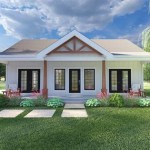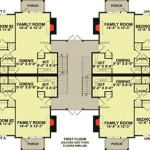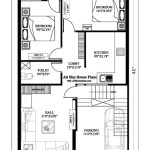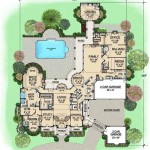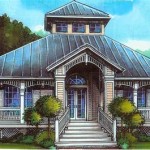Large Craftsman Style House Plans: Designing for Space and Tradition
The Craftsman style, originating in the late 19th and early 20th centuries, embodies simplicity, functionality, and handcrafted details. Characterized by its deep eaves, exposed rafters, prominent porches, and natural materials, the Craftsman aesthetic offers a warm and inviting atmosphere. When applied to large house plans, the Craftsman style provides an opportunity to create spacious, comfortable homes that retain a connection to nature and a sense of timeless elegance. This article explores key aspects of large Craftsman style house plans, focusing on design elements, functional considerations, and common architectural features.
Key Design Elements in Large Craftsman Houses
Craftsman architecture emphasizes horizontal lines, which often result in a low-pitched roof with wide overhanging eaves. This creates a sense of groundedness and stability, visually anchoring the house to the landscape. Gable roofs are common, sometimes featuring dormers to introduce light and ventilation to upper levels. Large Craftsman homes often incorporate multiple gables and rooflines to break up the massing and add visual interest. The depth and extent of the eaves are crucial for sun shading and protection from the elements, contributing to energy efficiency and comfort.
Porches are integral to the Craftsman style, providing a transition between indoor and outdoor spaces. Large Craftsman homes typically include a substantial front porch, often extending across a significant portion of the facade. These porches are often supported by thick, tapered columns or piers, frequently crafted from wood or stone. The porch serves as an outdoor living area, promoting interaction with the neighborhood and extending the living space during pleasant weather. The integration of seating areas, such as built-in benches or rocking chairs, enhances the porch's functionality and appeal.
Natural materials are essential to the Craftsman aesthetic. Wood, stone, and brick are commonly used for exterior cladding, often combined to create textural contrast and visual depth. Wood siding, typically in the form of clapboard, shingles, or board-and-batten, is a quintessential element. Stone or brick accents can be incorporated around the foundation, porch supports, or chimney to add a sense of permanence and craftsmanship. Interior finishes also prioritize natural materials, with exposed wood beams, hardwood floors, and handcrafted cabinetry being common features.
Windows in Craftsman homes are often multi-pane, with divided lites adding to the style's character. Casement windows, double-hung windows, and awning windows are all commonly used, often arranged in groupings to maximize natural light. Stained glass accents, particularly in entryways or above doorways, can add a touch of artistry and individuality. The size and placement of windows are carefully considered to optimize daylighting and ventilation, contributing to the home's overall energy efficiency.
Color palettes for large Craftsman homes typically draw inspiration from nature. Earthy tones, such as browns, greens, grays, and muted reds, are frequently used for exterior paint colors. Trim is often painted in contrasting shades to highlight architectural details. Interior color schemes often incorporate warm neutrals and accent colors inspired by natural elements, such as wood, stone, and foliage. The use of natural light and the inherent warmth of wood contribute to a cozy and inviting atmosphere.
Functional Considerations for Large Craftsman House Plans
The design of a large Craftsman house should prioritize functionality and practicality, reflecting the style's emphasis on efficient living spaces. Open floor plans are often incorporated to create a sense of spaciousness and facilitate interaction between different areas of the home. The kitchen, dining area, and living room are frequently connected, allowing for seamless flow and easy entertaining. However, distinct zones can be defined through the use of architectural details, such as archways, columns, or changes in floor level.
Large Craftsman homes typically include multiple bedrooms and bathrooms to accommodate families or guests. The master suite is often designed as a private retreat, featuring a spacious bedroom, a luxurious bathroom, and a walk-in closet. Additional bedrooms can be located on the upper level or in a separate wing of the house, providing privacy and separation. The inclusion of en-suite bathrooms for guest bedrooms enhances convenience and comfort.
Storage space is a crucial consideration in any large home. Craftsman design principles emphasize built-in storage solutions, such as bookcases, cabinets, and window seats with storage compartments. Walk-in closets, pantry spaces, and mudrooms provide ample storage for clothing, household items, and outdoor gear. The strategic placement of storage areas throughout the house helps to maintain a clutter-free and organized living environment.
Mudrooms, located near entrances, are particularly functional in Craftsman homes, providing a dedicated space for removing shoes, coats, and other outdoor items. These areas often include built-in benches, hooks, and shelving to facilitate organization and prevent the tracking of dirt and debris into the main living areas. Mudrooms can also serve as a transition zone between the garage and the house, providing convenient access for everyday activities.
Flexibility is an important aspect of large house plans. Spaces such as home offices, media rooms, or exercise rooms can be incorporated to cater to specific lifestyle needs. These areas can be designed to be adaptable over time, allowing for reconfiguration as the family's needs evolve. Attention to acoustics and lighting is crucial in these specialized spaces to ensure optimal functionality and comfort.
Common Architectural Features in Large Craftsman Style Houses
Exposed rafters, which are visible on the exterior of the house, are a defining characteristic of the Craftsman style. These rafters extend beyond the roofline, adding visual interest and emphasizing the horizontal lines of the house. The size and spacing of the rafters can be customized to suit the overall design aesthetic. The use of high-quality wood and meticulous craftsmanship is essential to create a durable and aesthetically pleasing feature.
Fireplaces are often a focal point in Craftsman living rooms, providing warmth and a sense of coziness. Fireplaces can be constructed from brick, stone, or a combination of materials. The mantelpiece is often crafted from wood and can be adorned with decorative details, such as corbels, carvings, or tile inlays. A well-designed fireplace serves as a gathering place for family and friends, enhancing the social atmosphere of the home.
Built-in cabinetry is a hallmark of Craftsman interiors, offering functional storage and contributing to the overall architectural detail. Bookcases, china cabinets, and entertainment centers can be seamlessly integrated into the walls, maximizing space and creating a cohesive design. The use of high-quality wood and handcrafted joinery is essential to create durable and visually appealing cabinetry. The style of the cabinetry should complement the overall aesthetic of the house, with simple lines and subtle ornamentation.
Arched doorways and entryways can add a touch of elegance and visual interest to Craftsman interiors. These arches can be subtle or dramatic, depending on the desired effect. Arches can be used to define different zones within an open floor plan or to create a sense of transition between rooms. The use of natural materials, such as wood or stone, can enhance the architectural impact of the arches.
Clerestory windows, which are located high on the walls, can be used to introduce natural light into interior spaces. These windows are particularly effective in areas with high ceilings or limited access to natural light. Clerestory windows can also enhance ventilation, allowing warm air to escape from the upper portion of the room. The design and placement of clerestory windows should be carefully considered to maximize their effectiveness and minimize glare.
In conclusion, large Craftsman style house plans offer a unique blend of spaciousness, functionality, and architectural charm. By incorporating key design elements, prioritizing functional considerations, and utilizing common architectural features, homeowners can create comfortable and inviting homes that reflect the timeless appeal of the Craftsman aesthetic. The emphasis on natural materials, handcrafted details, and connection to the outdoors makes large Craftsman homes a desirable choice for those seeking a blend of tradition and modern living.

Craftsman Style House Plan 3 Beds 2 Baths 2320 Sq Ft 132 200

Craftsman Style House Plans Big And Small Houseplans Blog Com

Craftsman Style House Plan 5 Beds 4 Baths 5250 Sq Ft 132 178 Houseplans Com
:max_bytes(150000):strip_icc()/SL-1873_FCP-8cf5801247c34df0b8bd839eeea78d4d.jpg?strip=all)
23 Craftsman Style House Plans We Can T Get Enough Of

Large Craftsman House Plans

Craftsman House Plans Style Home The Designers

Pin Page
:max_bytes(150000):strip_icc()/SL-1352_HallsleyStreetofHope_Front-b32f9541aca74779ae939f27bc9344c3.jpg?strip=all)
23 Craftsman Style House Plans We Can T Get Enough Of

Craftsman House Plans Style Floor

Craftsman House Plan With Photos 3 Bed 2 Bath 1879 Sq Ft




